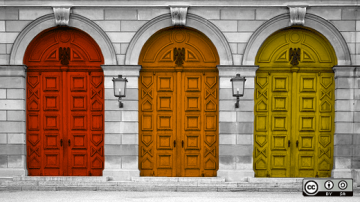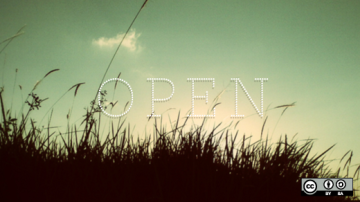Despite some quibbles I voiced in the first part of my review of Johan Norberg's Open: The Story of Human Progress, the author's argument remains engaging—especially at this historical juncture, as the world witnesses Russia's invasion of Ukraine, and authoritarian movements around the world are threatening the sustainability of the liberal democracies Norberg identifies as bastions of openness.
But if the world were to somehow make a transformational leap towards more global openness, what would actually be required? The conceptual challenge of that is daunting—but a first step might begin simply by articulating some of the unexplored questions that follow from Open's overall vision.
These are meaty questions, to be sure—about the actual "performance gains" more openness will deliver, about design considerations that any community would need to make if to pursue open transformation, and about how, precisely, that work would have to be undertaken in different contexts.
So in this second part of my reviewI want to elaborate a few of these. I'll also offer some explanation of how they pertain to the historical narrative Norberg lays out, and why now getting clear on them bears attention from any would-be open advocates and reformers. At the heart of inquiries here is a single, probing question: What can we actually do to promote more openness of the sort that Norberg envisions—if that is indeed something we desire?
What's the point of openness?
The first question Norberg raises for me is this: What, overall, is the purpose of pursuing more openness for one's entity? How do we more concretely define the goals of becoming more open?
This question may sound so obvious that it needn't even be raised. But, surprisingly, Norberg is much less explicit on the point than he should be. His argument waivers between the notion of "open" as a self-evident truth and, at other times, as the basis for a given historical success he imputes to this or that nation, based on, say, features like "greater innovation" and "community-wide problem-solving." My point here is not to deny the benefits of openness, but rather to push for an articulation of more specific and concretely defined benefits of open strategies that an organization or other entity is right to reach for.
For instance, if a benefit of greater openness is its impact on human "progress," then we need to articulate precisely what that term signifies. And that means the possibility of inviting criticisms. Recently, for example, in another spirited but also controversial book, Enlightenment Now, Steven Pinker took a cut at the difficult work of defining "progress." For him, progress can be made concrete and measurable by assessing modernity's improvement against several specific variables of human civilization (e.g., increase in life-span, more positive healthcare outcomes, growth of wealth, increase of knowledge, etc.). Pinker associates such improvements that benefit us today with the growth of reason, science and humanism—Enlightenment values forged over the last several centuries. His charge to modern societies is to keep building progress by fortifying and extending such Enlightenment practices. Pinker's approach to explaining progress has been variously challenged, but his case at least begins with a firm definitional stake in the ground.
We should expect the same of Norberg's manifesto. As Norberg explains, humans' psychological and sociological tendencies often create ongoing barriers to sustaining open approaches to life and work. If we're to undertake the (clearly difficult) work of fostering more open institutions, we'll want to understand specifically the value these approaches deliver, and why we should push for them.
In other words, what's the real prize for all the trouble?
Norberg's overall conceit about purpose (to which I'm sympathetic) is fundamentally practical: we should pursue openness because it creates and facilitates material improvements and superior success for whatever members of a society are trying to achieve, as well as broader economic welfare. But he also says little about less material aspects of life in an open community: the joys and fulfillment of greater individual freedom, and the horizon-broadening exposure to new ideas and cultural inputs. These are more intangible and somewhat relative, historically contingent, and perhaps more fraught. As Norberg observes, horizon-broadening exposure to other cultural influences can also be the fuel of tribal antagonism—not a benefit for many people, but rather a source of identity-threatening fear.
And how does this intersect with the view that greater openness is less about any benefits to incumbent members of a nation and more about satisfying the human rights of newcomers to it? For many constituents in liberal democracies, openness is less an opportunistic strategy and more a moral obligation to fellow humans. Tensions between this view and others point to the need for more intentional discussion of the purpose of—and goals in potentially pursuing—any stance of greater openness.
What's the scale of openness?
The next question Norberg's Open raises for me is: What 'unit(s) of analysis' are the appropriate focus of "open-building?"Do different entities require different approaches to "open?"
By "unit of analysis," I mean the size and nature of the entity being studied—a fancy phrase that asks about the "relative bigness" and make-up of whatever human grouping one is trying to make more open. Norberg's aim is bold: raise existing discussions about open innovation and cross-boundary collaboration in business organizations and open software networks to much greater scale, examining political, cultural, and economic entities (including nation states, empires, and entire civilizations). From time to time, he also focuses on smaller organizational forms (cities, indigenous communities, and groups of nomadic peoples). For Norberg, "more open" benefits human groupings of any size.
But does it always? Because his understanding of what makes for "progress" is so fluid, one wonders if the concept itself not only needs stricter definition, but also if it scales in all the ways Norberg believes. Taking as a hypothesis that the answer to the latter is "yes," further analysis would look for differentiation, segmentation of type, and appropriate qualification of what "open" can expect to deliver at these various scales.
If indeed "open" always delivers some kind of progress, we could sharpen our understanding of why and how it does this, given the substantial differences among different kinds of organizations and human groupings. We might also examine the question of whether there's some upper limit to size. Can a culture and set of practices for open innovation expand infinitely, or does it ultimately hit a ceiling?
What's the limit of openness?
Next, I wonder: Does "open" ever need to respect certain boundaries? When, where, and why?
The "unit of analysis question" presumes that some entities might strive to be open, but others—perhaps because they're bigger, smaller, or simply different—may not. The implication here is that openness involves limits or boundaries. But Norberg leaves unresolved the question of whether "open" has boundaries. Does an open world, for instance, mean one in which significant distinctions between all entities eventually disappear, because no boundaries should exist between any human groupings, lest tribal enmity flourish and progress cease? If this latter condition is part of Norberg's vision (when discussing climate change, he edges slightly in this direction), it's certainly not implied in most of his discussion. Instead, following the lessons of history, he suggests that some entities will be more open than others, and those that are will fare better.
Then, a follow-on issue: If leaders or citizens of a certain society, nation, or extended community decide to open themselves up, when and how do they draw any kind of boundaries at all? This leads to a host of related questions, all familiar to anyone who has studied open organizational design, implementation, or practice:
- Who defines membership for participating and enjoying the fruits of openness?
- What (if any) rights and privileges confer to members of a community or society who aren't full "members," and how will those be determined?
- Who, if anyone, should not be allowed to join an open community? Is potential exclusion based on nefarious designs for individual greed and power? Because an entity wishes ill upon the well-intentioned, more open members? Or are there other suitable prohibitions?
- What principles, practices, and institutions are necessary to decide and defend certain boundaries (both in terms of people and territory, and even including virtual networks), given that boundaries themselves can undermine openness, even if they are also necessary to defend and preserve it?
What's the best way to foster openness?
Norberg's book raises one final question for me: What form of governance is needed to advance and sustain openness?
Towards the end of his book, Norberg seems to imply that liberal democracies are the most appropriate stewards of open societies. That seems logical enough. But as we've seen, his historical survey celebrates openness as achieved and/or utilized by the harsh Mongolian emperor Genghis Kahn, Roman imperial rulers, and 18th C. Britain under William of Orange (who worked with an elected parliament but remained a monarch with still substantial powers). Norberg also notes that modern China has been experimenting, so far relatively successfully, with a blend of authoritarian rule and more open economic practices. To what degree, and in what ways, is "open" independent of the kind of rule that organizes the society that might benefit from it? What systems or regimes of governance espouse the most viable "vision" of openness? And how do those systems structure decision-making power?
An organization's governance model is critical not just to creating openness but also to sustaining that posture over time (especially given all the human tendencies to retreat from the natural challenges and setbacks it brings, as Norberg elaborates). Consider, for example, some of the critical, but also enduring, decisions that governing institutions and their leaders must make in connection with both development and maintenance of openness:
Agreeing on the boundaries of and membership in an open community: Decisions about both are never static or settled. Expansion or contraction of territory, growth of new populations, changing diversity and complexity of members who compose the community—all require new decisions and potential changes or refinements to past agreements. Maintaining what it means to be open, and for whom and where, must be a continuing process managed on behalf of all members (and would-be members, too).
Defending those boundaries and membership(s): The maintenance of the open society is not only about achieving what might be called "internal agreement" among membership stakeholders, but also about warding off external threats or major challenges to those decisions by hostile outside powers. Open societies must ultimately struggle with both domestic and foreign challenges to how open they think they wish to be.
Defining the excellence that justifies openness: Norberg glosses over any explicit discussion of this, but the book's implied premise is that open societies ultimately thrive because they foster competitive selection of the "best ideas," which leads to innovation. In other words, open societies win and thrive because they make decisions according to some standard of "excellence"—not familiarity, parochial preferences, or ideological priorities. But "excellence" is not always always simple and self-evident to any particular community: What criteria will be used to define it? How will conflicts about it be resolved? How will it be maintained as the pre-eminent basis for action? These are governance questions, and members of open communities themselves—or those entrusted to govern it—must agree on how those challenges will be met and differing opinions among members mediated.
Defining whether and how those who achieve excellence will be differentially entitled or rewarded: This question, which follows directly from the above issue, moves from understanding what excellence is to agreeing who deserves to benefit from it. In short, it's a question of organizational governance. And as I've framed it here, it's a question of a governance model often called "meritocracy" (meaning those with the greatest knowledge, skills and accomplishment should be recognized by a society's people as most worthy to lead, and also to bear the greatest burdens of ensuring the greater good for all). Today, however, meritocracy is a term fraught and contested, particularly among those who criticize its associated systems of excessive credentialism (status conferred by educational degrees, not objective performance), and concerns that reliance on judgment by excellence unfairly discounts the social scaffolding that helps some people more than others achieve success. Others simply argue that meritocracy undermines the dignity and equality upon which democratic governance models depend. Such controversies do not directly relate to social and economic strategies for pursuing openness, but they will ultimately be pulled into efforts aimed at intentionally creating it. Similarly, like questions of boundaries and membership, societal concepts of what makes excellence and how merit should be judged will require ongoing adjustment and revision, as the entity grows larger and more complex (which performance success tends to drive).
When and how to modify any community's state of "openness" when required: The history of democratic (or generally "open" communities or nations) is filled with examples when their peoples decide that openness must be reduced or curtailed—sometimes temporarily, sometimes more enduringly. Ancient Athens became steadily more elitist—less open—about its citizenship during the "Golden Age." Ancient Romans, during the period of their Republic, enacted a law to allow temporary suspensions of freedoms and the appointment of a dictator in times of grave emergency, a measure abused by Julius Caesar when he made himself a more permanent king. But during Rome’s later imperial age, despite the overall autocratic rule, social mobility and commercial relationships became steadily more open. Modern American democracy has witnessed periods of welcoming immigration and open trade and others of exclusionary practices and high tariffs. Openness inevitably becomes a moving target, as populations, external events, and social beliefs change. How should future open-seeking societies and nations govern a process that can never stand still?
It is the great value of Norberg’s book that it can inspire and raise hope for a generally more open world. But the conundrums that come along with such aspirations now require much more thinking from the rest of us—from both academic study but also the harsh lessons of practice.








Comments are closed.